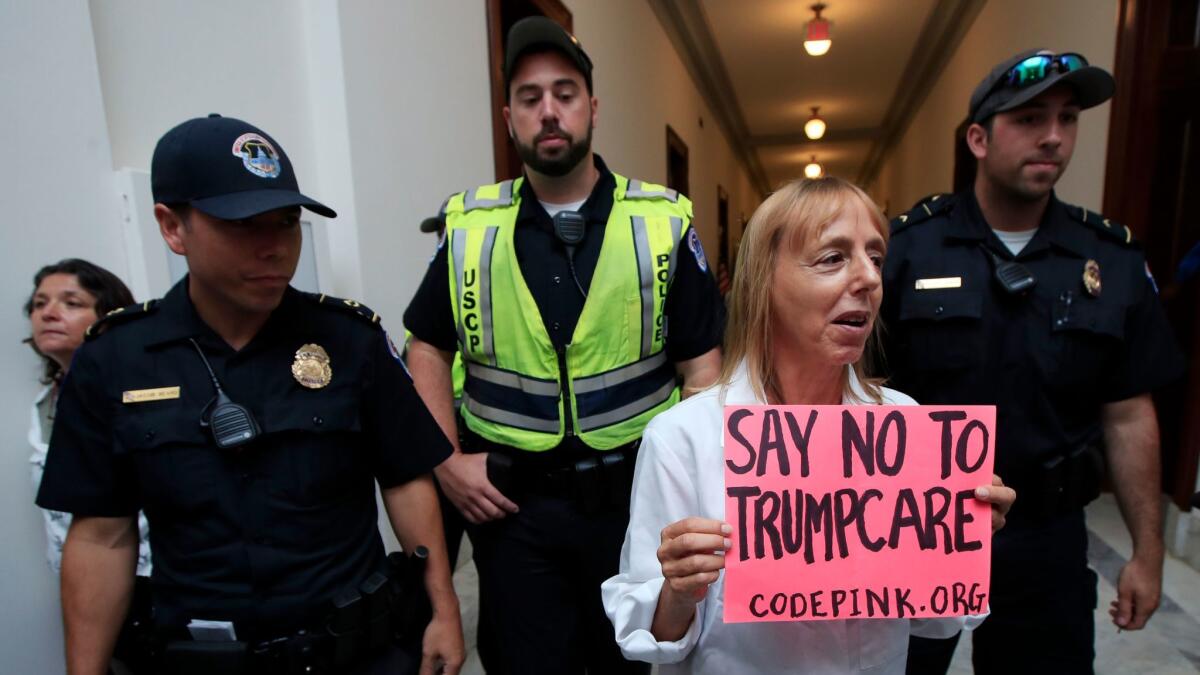Column: Democrats and Republicans should now agree on these real fixes for Obamacare

- Share via
Now what?
With Monday’s collapse of the Senate Republicans’ latest effort to repeal the Affordable Care Act, the GOP and the Trump White House are confronted with the question of what to do next, if anything, on healthcare. But that’s a question for Democrats, too.
Although there’s a general perception that Democrats consider Obamacare to be the last word on healthcare policy, that’s never been true. The ACA was the product of compromise from its inception, and also something of an experiment. No one was sure how all its moving parts would work. The law’s drafters and supporters expected that real-world experience would allow them to come back and strengthen the provisions that were working and fix those that weren’t. Those expectations were dashed by the GOP’s seven-year insistence that revision of the ACA begin and end with repeal.
Regretfully, it is now apparent that the effort to repeal and immediately replace the failure of Obamacare will not be successful.
— Senate Majority Leader Mitch McConnell (R-Ky.) announces the collapse of Obamacare repeal
But there’s no dearth of proposals for making the ACA work better. With exquisite timing, Andrew Sprung of Xpostfactoid on Monday afternoon unearthed a package proposed in January by John Holahan and Linda J. Blumberg of the Urban Institute. It’s an excellent starting point that attempts to balance improvements to the law with concessions that Republicans might find palatable enough to bring on board.
It might yet be premature to start this effort, however. Senate Majority Leader Mitch McConnell (R-Ky.), the architect of the failed Senate repeal effort and its goat, reacted to the collapse Monday night by announcing plans to vote on a full repeal of Obamacare with a two-year delay “to provide for a stable transition period.” The idea is to resurrect a repeal bill that passed by Republican majorities in both houses in 2015.
Those votes were taken, however, in the full knowledge that the measure would be vetoed by President Obama, which is exactly what happened. It would presumably by signed by President Trump. If so, it would be even more of a disaster for American healthcare than the failed repeal proposals; the Congressional Budget Office forecast that it would lead to lost coverage for 32 million Americans by 2026 compared to existing law — much higher than the 22 million to 24 million who would be affected by Republican repeal measures this year — and a doubling of premiums by that date.
If Republicans and Democrats could come together in a good-faith effort to improve the Affordable Care Act, what should be on the table? Here’s a digest of the suggestions for fixes and concessions offered by Holahan and Blumberg.
First, the fixes.
-- Expand the subsidies. As the Urban Institute authors observe, the ACA’s premium subsidies are too low, and the income cutoff too sharp, to make coverage truly affordable for many working- and middle-class families. Under current law, subsidies are provided to households earning up to 400% of the federal poverty line, or $98,400 for a family of four. They’re entitled to enough so that the cost of a benchmark silver-level health plan, which would cover an average 70% of medical expenses, won’t cost them more than 9.69% of their income.
Above 400%, however, the subsidies disappear. Holahan and Blumberg calculated in a separate study that households just above the cutoff — those earning 400% to 500% of the poverty level — took the greatest hit in insurance costs, paying a median 18.1% of their income in premiums and out-of-pocket expenses. That accounts for complaints that the ACA increased the cost burdens on the middle class in order to pay for better benefits for lower-income households, and explains why the law has struggled to win approval from more than a bare 50% of Americans.
Holahan and Blumberg propose lowering the cost cap to 8.5% of income and applying it to all households, whatever their earnings. This wouldn’t be much of a windfall for higher-income families, they argue, because premiums and out-of-pocket spending don’t normally increase with income, so as income rises, the share spent on health coverage falls naturally. They also would peg subsidies to a gold-level plan, which covers an average 80% of expenses, rather than silver. Gold plans typically have lower deductibles and co-pays.
--Step up education and outreach. The effectiveness of such efforts is well-established. States with vigorous public outreach programs, such as California, consistently have experienced higher ACA exchange enrollment than those that neglected them or even interfered. And the Trump administration’s cutback of ACA outreach and marketing immediately after the inauguration is widely blamed for a slowdown in ACA exchange enrollments in January and February this year, relative to the same period in previous years.
The rationale is inescapable. Once Republicans capitulate to the reality that the ACA is here to stay, there’s no reason not to make sure that the largest share of eligible beneficiaries know to sign up.
--Cap payments to doctors and hospitals. Reduced competition among health plans in some regions, a problem under the ACA touted incessantly by the GOP, leads to higher reimbursement rates for medical providers and consequently higher premiums. Holahan and Blumberg have a simple solution drawn from Medicare: cap those reimbursements. It’s unlikely that limiting them to Medicare rates or slightly higher would drive providers out of the market — Medicare has little trouble signing up doctors and hospitals to serve their enrollees.
And now, the givebacks.
What concessions could Democrats offer to bring Republicans to the table?
-- Replace the individual mandate. This is by far the most unpopular element of the Affordable Care Act, and the focus of the GOP’s pitch that Americans shouldn’t be forced to buy anything they don’t want. Some means of goading healthier people into buying insurance is obviously a necessary adjunct to the ACA’s requirement that every buyer be offered essentially the same price, regardless of medical history — which is a part of the law that Americans widely favor.
The question is what sort of goad? Senate and House Republicans proposed replacing the tax penalties imposed on those without insurance with a waiting period for anyone who allowed a lapse in his or her coverage for at least two months. During the wait, the enrollee’s preexisting conditions wouldn’t be covered; but that raises the issue of how to protect such buyers from what could be catastrophic costs in the meantime.
Holahan and Blumberg suggest instead a version of the late-enrollment penalties imposed under Medicare Parts B and D. These voluntary parts of Medicare, covering doctor and outpatient visits and prescription drugs, are partially paid by enrollees. Those who wait past their initial eligibility periods to sign up are hit with lifetime premium surcharges.
Holahan and Blumberg propose that ACA penalties be limited — say to one or two years — instead of permanent. The goal is to “make the penalties strong enough to be effective in maximizing enrollment, yet not so punitive” that people wouldn’t be able to afford coverage if they’re subject to the penalties.
One objection to the late-enrollment penalties is that many people wouldn’t even be aware of them until they tried to enroll, which makes them comparatively ineffective in prompting holdouts to buy coverage. The solution is to make them aware, through education and outreach.
-- Kill the employer mandate. Even pro-ACA economists acknowledge that it achieves little, especially when balanced against its unpopularity. Employers already have strong incentives to offer their workers health coverage, including tax benefits and the need to attract and keep productive employees.
-- Expand Health Savings Accounts. HSAs, which are tax-advantaged accounts that can be used to pay out-of-pocket medical expenses, are a boon to high-income households because they permit yet more sheltering of income from taxes. That’s why the GOP has placed them front-and-center among its Obamacare “replacement” ideas. But despite the GOP’s claims that HSAs are good for everyone, for working-class families with limited income tax liability and little disposable income to use to fund the accounts, they’re relatively useless. The Tax Policy Center calculated that more than 16% of all households with $200,000 in income or more have HSAs — but fewer than 2% of households earning less than $30,000 do.
The Senate and House proposed raising the maximum annual contribution limits for HSAs to $6,550 for individuals and $13,100 for families, up from $3,450 for individuals and $6,750 for families. Here’s an idea for the Democrats: Let them. As a substitute for genuine ACA reform, HSAs were a fraud; but as a bargaining chip for real improvements, they have value. Expanding them wouldn’t increase coverage, since the wealthier families that hold them already have effective coverage. But it wouldn’t hurt much, either.
-- Kill the “Cadillac tax.” Among the ACA provisions that Democrats and Republicans all hate is this tax, which is imposed on high-cost employer-sponsored and multi-employer (that is, union-sponsored) health plans. The law levies a 40% tax on health plans valued at more than $10,200 for individual coverage and $27,500 for family coverage and union plans. The tax has been delayed to 2020.
The tax was designed in part to equalize the treatment of employer plans, which are tax-deductible for both employers and workers, and individual plans, which are not. But there are probably justified fears that employers will respond by reducing the coverage they provide. Republicans hate the tax because it hits business; Democrats because it hits unionized workers.
So bury it. Since the tax is projected to bring in about $70 billion over 10 years, that funding will have to be replaced somehow, but that shouldn’t be too difficult for Republicans and Democrats working together, should it?
Some elements of the ACA need to be preserved at all costs. They include the law’s roster of Essential Health Benefits that all plans must cover, including hospitalization, mental health and substance abuse treatment, maternity care, and prescriptions. Republicans have argued in favor of cutting back the list or eliminating the mandate entirely, but that just opens the door to the return of junk insurance and the loss of protection for preexisting conditions, without any appreciable savings. The absence of any consensus within the Republican caucus on EHBs undoubtedly contributed to the GOP’s repeal failure, since most lawmakers seem to understand, in their hearts, that these benefits really are the essence of decent health insurance. They should be off the table.
But that leaves a smorgasbord of workable options. Once the GOP divorces itself from an ideological commitment to repealing the ACA, the Democrats may well be inclined to a bit of horse-trading to achieve the improvements that almost everyone agrees are warranted. Let the bargaining begin, for all Americans’ sakes.
Keep up to date with Michael Hiltzik. Follow @hiltzikm on Twitter, see his Facebook page, or email [email protected].
Return to Michael Hiltzik’s blog.
More to Read
Get the L.A. Times Politics newsletter
Deeply reported insights into legislation, politics and policy from Sacramento, Washington and beyond. In your inbox three times per week.
You may occasionally receive promotional content from the Los Angeles Times.











